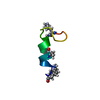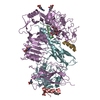[English] 日本語
 Yorodumi
Yorodumi- PDB-7u6e: Head region of insulin receptor ectodomain (A-isoform) bound to t... -
+ Open data
Open data
- Basic information
Basic information
| Entry | Database: PDB / ID: 7u6e | ||||||
|---|---|---|---|---|---|---|---|
| Title | Head region of insulin receptor ectodomain (A-isoform) bound to the non-insulin agonist IM462 | ||||||
 Components Components |
| ||||||
 Keywords Keywords | HORMONE/SIGNALING PROTEIN/AGONIST / insulin receptor / insulin-mimic peptide / insulin receptor agonist / HORMONE-SIGNALING PROTEIN-AGONIST complex | ||||||
| Function / homology |  Function and homology information Function and homology informationnegative regulation of NAD(P)H oxidase activity / negative regulation of glycogen catabolic process / positive regulation of nitric oxide mediated signal transduction / negative regulation of fatty acid metabolic process / negative regulation of feeding behavior / Signaling by Insulin receptor / IRS activation / Insulin processing / regulation of protein secretion / positive regulation of respiratory burst ...negative regulation of NAD(P)H oxidase activity / negative regulation of glycogen catabolic process / positive regulation of nitric oxide mediated signal transduction / negative regulation of fatty acid metabolic process / negative regulation of feeding behavior / Signaling by Insulin receptor / IRS activation / Insulin processing / regulation of protein secretion / positive regulation of respiratory burst / positive regulation of peptide hormone secretion / negative regulation of acute inflammatory response / Regulation of gene expression in beta cells / alpha-beta T cell activation / regulation of cellular amino acid metabolic process / negative regulation of respiratory burst involved in inflammatory response / positive regulation of dendritic spine maintenance / positive regulation of glycogen biosynthetic process / Synthesis, secretion, and deacylation of Ghrelin / negative regulation of protein secretion / regulation of protein localization to plasma membrane / fatty acid homeostasis / Signal attenuation / negative regulation of lipid catabolic process / FOXO-mediated transcription of oxidative stress, metabolic and neuronal genes / negative regulation of gluconeogenesis / COPI-mediated anterograde transport / positive regulation of lipid biosynthetic process / negative regulation of oxidative stress-induced intrinsic apoptotic signaling pathway / negative regulation of reactive oxygen species biosynthetic process / positive regulation of insulin receptor signaling pathway / nitric oxide-cGMP-mediated signaling / transport vesicle / positive regulation of protein autophosphorylation / Insulin receptor recycling / neuron projection maintenance / positive regulation of protein metabolic process / NPAS4 regulates expression of target genes / positive regulation of brown fat cell differentiation / positive regulation of glycolytic process / activation of protein kinase B activity / endoplasmic reticulum-Golgi intermediate compartment membrane / positive regulation of mitotic nuclear division / Insulin receptor signalling cascade / positive regulation of nitric-oxide synthase activity / positive regulation of cytokine production / positive regulation of long-term synaptic potentiation / acute-phase response / endosome lumen / Regulation of insulin secretion / positive regulation of glucose import / positive regulation of protein secretion / negative regulation of proteolysis / positive regulation of cell differentiation / regulation of transmembrane transporter activity / insulin-like growth factor receptor binding / wound healing / insulin receptor binding / regulation of synaptic plasticity / negative regulation of protein catabolic process / hormone activity / receptor protein-tyrosine kinase / cognition / positive regulation of neuron projection development / positive regulation of protein localization to nucleus / Golgi lumen / vasodilation / glucose metabolic process / regulation of protein localization / insulin receptor signaling pathway / cell-cell signaling / glucose homeostasis / positive regulation of NF-kappaB transcription factor activity / PI5P, PP2A and IER3 Regulate PI3K/AKT Signaling / positive regulation of cell growth / protease binding / secretory granule lumen / positive regulation of MAPK cascade / positive regulation of phosphatidylinositol 3-kinase/protein kinase B signal transduction / positive regulation of cell migration / G protein-coupled receptor signaling pathway / Amyloid fiber formation / endoplasmic reticulum lumen / Golgi membrane / negative regulation of gene expression / positive regulation of cell population proliferation / positive regulation of gene expression / regulation of DNA-templated transcription / extracellular space / extracellular region / identical protein binding Similarity search - Function | ||||||
| Biological species |  Homo sapiens (human) Homo sapiens (human)synthetic construct (others) | ||||||
| Method | ELECTRON MICROSCOPY / single particle reconstruction / cryo EM / Resolution: 3 Å | ||||||
 Authors Authors | Kirk, N.S. / Lawrence, M.C. | ||||||
| Funding support |  United States, 1items United States, 1items
| ||||||
 Citation Citation |  Journal: Nat Commun / Year: 2022 Journal: Nat Commun / Year: 2022Title: Activation of the human insulin receptor by non-insulin-related peptides. Authors: Nicholas S Kirk / Qi Chen / Yingzhe Ginger Wu / Anastasia L Asante / Haitao Hu / Juan F Espinosa / Francisco Martínez-Olid / Mai B Margetts / Faiz A Mohammed / Vladislav V Kiselyov / David ...Authors: Nicholas S Kirk / Qi Chen / Yingzhe Ginger Wu / Anastasia L Asante / Haitao Hu / Juan F Espinosa / Francisco Martínez-Olid / Mai B Margetts / Faiz A Mohammed / Vladislav V Kiselyov / David G Barrett / Michael C Lawrence /    Abstract: The human insulin receptor signalling system plays a critical role in glucose homeostasis. Insulin binding brings about extensive conformational change in the receptor extracellular region that in ...The human insulin receptor signalling system plays a critical role in glucose homeostasis. Insulin binding brings about extensive conformational change in the receptor extracellular region that in turn effects trans-activation of the intracellular tyrosine kinase domains and downstream signalling. Of particular therapeutic interest is whether insulin receptor signalling can be replicated by molecules other than insulin. Here, we present single-particle cryoEM structures that show how a 33-mer polypeptide unrelated to insulin can cross-link two sites on the receptor surface and direct the receptor into a signalling-active conformation. The 33-mer polypeptide engages the receptor by two helical binding motifs that are each potentially mimicable by small molecules. The resultant conformation of the receptor is distinct from-but related to-those in extant three-dimensional structures of the insulin-complexed receptor. Our findings thus illuminate unexplored pathways for controlling the signalling of the insulin receptor as well as opportunities for development of insulin mimetics. | ||||||
| History |
|
- Structure visualization
Structure visualization
| Structure viewer | Molecule:  Molmil Molmil Jmol/JSmol Jmol/JSmol |
|---|
- Downloads & links
Downloads & links
- Download
Download
| PDBx/mmCIF format |  7u6e.cif.gz 7u6e.cif.gz | 200.1 KB | Display |  PDBx/mmCIF format PDBx/mmCIF format |
|---|---|---|---|---|
| PDB format |  pdb7u6e.ent.gz pdb7u6e.ent.gz | 152 KB | Display |  PDB format PDB format |
| PDBx/mmJSON format |  7u6e.json.gz 7u6e.json.gz | Tree view |  PDBx/mmJSON format PDBx/mmJSON format | |
| Others |  Other downloads Other downloads |
-Validation report
| Summary document |  7u6e_validation.pdf.gz 7u6e_validation.pdf.gz | 1 MB | Display |  wwPDB validaton report wwPDB validaton report |
|---|---|---|---|---|
| Full document |  7u6e_full_validation.pdf.gz 7u6e_full_validation.pdf.gz | 1 MB | Display | |
| Data in XML |  7u6e_validation.xml.gz 7u6e_validation.xml.gz | 39.5 KB | Display | |
| Data in CIF |  7u6e_validation.cif.gz 7u6e_validation.cif.gz | 57.1 KB | Display | |
| Arichive directory |  https://data.pdbj.org/pub/pdb/validation_reports/u6/7u6e https://data.pdbj.org/pub/pdb/validation_reports/u6/7u6e ftp://data.pdbj.org/pub/pdb/validation_reports/u6/7u6e ftp://data.pdbj.org/pub/pdb/validation_reports/u6/7u6e | HTTPS FTP |
-Related structure data
| Related structure data |  26364MC  7u6dC  8di2C M: map data used to model this data C: citing same article ( |
|---|---|
| Similar structure data | Similarity search - Function & homology  F&H Search F&H Search |
- Links
Links
- Assembly
Assembly
| Deposited unit | 
|
|---|---|
| 1 |
|
- Components
Components
-Protein/peptide , 3 types, 4 molecules ABGH
| #1: Protein/peptide | Mass: 2383.698 Da / Num. of mol.: 1 / Fragment: UNP residues 90-110 Source method: isolated from a genetically manipulated source Source: (gene. exp.)  Homo sapiens (human) / Gene: INS / Production host: Homo sapiens (human) / Gene: INS / Production host:  |
|---|---|
| #2: Protein/peptide | Mass: 3433.953 Da / Num. of mol.: 1 / Fragment: UNP residues 25-54 Source method: isolated from a genetically manipulated source Source: (gene. exp.)  Homo sapiens (human) / Gene: INS / Production host: Homo sapiens (human) / Gene: INS / Production host:  |
| #4: Protein/peptide | Mass: 2644.862 Da / Num. of mol.: 2 / Source method: obtained synthetically / Source: (synth.) synthetic construct (others) |
-Protein , 1 types, 2 molecules EF
| #3: Protein | Mass: 106728.211 Da / Num. of mol.: 2 / Fragment: ectodomain (UNP residues 28-943) Source method: isolated from a genetically manipulated source Details: delta beta construct, leucine-zippered form / Source: (gene. exp.)  Homo sapiens (human) / Gene: INSR / Production host: Homo sapiens (human) / Gene: INSR / Production host:  References: UniProt: P06213-2, receptor protein-tyrosine kinase |
|---|
-Sugars , 2 types, 7 molecules 
| #5: Polysaccharide | 2-acetamido-2-deoxy-beta-D-glucopyranose-(1-4)-2-acetamido-2-deoxy-beta-D-glucopyranose Source method: isolated from a genetically manipulated source |
|---|---|
| #6: Sugar | ChemComp-NAG / |
-Details
| Has ligand of interest | N |
|---|
-Experimental details
-Experiment
| Experiment | Method: ELECTRON MICROSCOPY |
|---|---|
| EM experiment | Aggregation state: PARTICLE / 3D reconstruction method: single particle reconstruction |
- Sample preparation
Sample preparation
| Component | Name: Complex of IM462 with insulin and Fv 83-7 bound to insulin receptor, delta beta, leucine zippered form Type: COMPLEX / Entity ID: #1-#4 / Source: MULTIPLE SOURCES |
|---|---|
| Source (natural) | Organism:  Homo sapiens (human) Homo sapiens (human) |
| Source (recombinant) | Organism:  |
| Buffer solution | pH: 8 |
| Specimen | Embedding applied: NO / Shadowing applied: NO / Staining applied: NO / Vitrification applied: YES |
| Vitrification | Cryogen name: ETHANE |
- Electron microscopy imaging
Electron microscopy imaging
| Experimental equipment |  Model: Titan Krios / Image courtesy: FEI Company |
|---|---|
| Microscopy | Model: FEI TITAN KRIOS |
| Electron gun | Electron source:  FIELD EMISSION GUN / Accelerating voltage: 300 kV / Illumination mode: FLOOD BEAM FIELD EMISSION GUN / Accelerating voltage: 300 kV / Illumination mode: FLOOD BEAM |
| Electron lens | Mode: BRIGHT FIELD / Nominal defocus max: 2000 nm / Nominal defocus min: 500 nm |
| Image recording | Electron dose: 60 e/Å2 / Film or detector model: GATAN K3 (6k x 4k) |
- Processing
Processing
| Software | Name: PHENIX / Version: 1.19.2_4158: / Classification: refinement | ||||||||||||||||||||||||
|---|---|---|---|---|---|---|---|---|---|---|---|---|---|---|---|---|---|---|---|---|---|---|---|---|---|
| CTF correction | Type: PHASE FLIPPING AND AMPLITUDE CORRECTION | ||||||||||||||||||||||||
| 3D reconstruction | Resolution: 3 Å / Resolution method: FSC 0.143 CUT-OFF / Num. of particles: 346000 / Symmetry type: POINT | ||||||||||||||||||||||||
| Refinement | Cross valid method: NONE Stereochemistry target values: GeoStd + Monomer Library + CDL v1.2 | ||||||||||||||||||||||||
| Displacement parameters | Biso mean: 54.74 Å2 | ||||||||||||||||||||||||
| Refine LS restraints |
|
 Movie
Movie Controller
Controller



 PDBj
PDBj


















